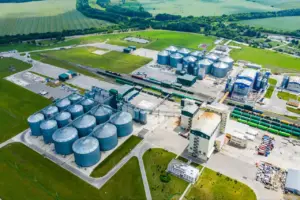
why BioCNG in news?
- Provide more context on the significance of the initiative in Banaskantha district and its potential impact on waste management and rural economy.
- Include statistics or examples highlighting the challenges faced by dairy farmers and the importance of finding sustainable solutions.
Dung Facts:
- Elaborate on the process of methane production in bovine animals and its implications for biogas production.
- Discuss the environmental benefits of utilizing methane from dung for energy production, such as reducing greenhouse gas emissions.
Biogas Production, Purification, and Compression:
- Biogas Production Process:
- Hydrolysis: Complex organic compounds in biomass are broken down into simpler molecules by hydrolytic bacteria.
- Acidogenesis: Acidogenic bacteria further metabolize products into volatile fatty acids and hydrogen.
- Acetogenesis: Acetogenic bacteria convert intermediates into acetic acid, CO2, and hydrogen.
- Methanogenesis: Methanogenic archaea produce methane and CO2 from hydrogen and CO2.
- Examples of successful biogas projects:
- Gobar Gas in India: Utilizes cattle dung to produce biogas for cooking, improving indoor air quality and reducing deforestation.
- Biogas Plants in Europe: Large-scale plants utilize various organic feedstocks for electricity generation and fertilizer production, contributing to renewable energy and waste diversion.
- Biogas Purification and Compression:
- Purification Technologies: Pressure swing adsorption, water scrubbing, chemical scrubbing, and membrane separation remove impurities from biogas.
- Compression Methods: Compressors increase the energy density of purified biogas for storage and transportation.
- Economic Feasibility and Potential Impact:
- Cost Savings: BioCNG production offers cost savings compared to fossil fuels, generating revenue streams and reducing waste disposal costs.
- Environmental Sustainability: BioCNG reduces greenhouse gas emissions, mitigates odor and pollution from organic waste, and promotes circular economy principles.
Utilization of Slurry for Fertilizer Production:
- Benefits of Organic Manure from Biogas Slurry:
- Environmental Benefits: Organic manure improves soil structure, enhances water retention, and promotes biodiversity compared to chemical fertilizers. It also reduces the risk of nutrient leaching and groundwater contamination.
- Soil Health: Organic manure enriches the soil with essential nutrients and micronutrients, fostering healthier plant growth and reducing the need for synthetic inputs.
- Examples of Agricultural Practices Benefiting from Organic Manure:
- Organic Farming:
- Organic farmers utilize biogas slurry-derived organic manure to maintain soil fertility and support sustainable crop production without relying on synthetic chemicals.
- Crop Rotation:
- Integrating organic manure into crop rotation systems enhances soil fertility over time, leading to higher yields and improved crop quality.
- Organic Farming:
- Challenges and Opportunities for Scaling up BioCNG Production:
- Feedstock Availability:
- Ensuring a consistent supply of organic feedstock is crucial for scaling up BioCNG production. Developing efficient waste collection and segregation systems can help overcome this challenge.
- Infrastructure Development:
- Investing in infrastructure such as biogas plants, purification facilities, and distribution networks is essential for expanding BioCNG production capacity.
- Feedstock Availability:
- Successful Case Studies of Decentralized Biogas Projects:
- Flexi Biogas Plants in Gujarat:
- The installation of decentralized Flexi Biogas Plants in Gujarat has enabled individual farmers to produce BioCNG from cattle dung, providing additional income and reducing reliance on traditional energy sources.
- Rural Development Impact:
- Decentralized biogas projects have empowered rural communities by creating employment opportunities, improving access to clean energy, and promoting sustainable agriculture practices.
- Flexi Biogas Plants in Gujarat:
Key Challenges:
- Provide more in-depth analysis of each challenge mentioned, including potential solutions and best practices.
- Include interviews or quotes from experts, policymakers, or stakeholders involved in biogas projects.
India’s Initiatives Related to Biogas:
- Discuss the objectives and outcomes of the SATAT Scheme, GOBARdhan initiative, and National Biogas Programme in greater detail.
- Highlight success stories and lessons learned from these initiatives.
People also ask
Q1: What is BioCNG?
Ans: BioCNG, or compressed natural gas, is a renewable energy source produced from organic waste, such as cattle dung, through the process of anaerobic digestion. It primarily consists of methane and can be used as a clean fuel for various applications, including transportation and cooking.
Q2: How is BioCNG produced from dung?
Ans: BioCNG production begins with the collection of fresh dung, which is mixed with water to form a slurry. This slurry undergoes anaerobic digestion in a sealed vessel reactor over a period of 35 days, resulting in the production of biogas. The biogas is then purified and compressed to produce BioCNG.
Q3: What are the benefits of using organic manure produced from biogas slurry?
Ans: Organic manure derived from biogas slurry offers several benefits compared to chemical fertilizers, including improved soil structure, enhanced water retention, and reduced risk of nutrient leaching. It also promotes soil health and biodiversity while reducing dependence on synthetic inputs.
Q4: How scalable is BioCNG production?
Ans: BioCNG production has the potential for scalability, with opportunities to expand production capacity by utilizing organic waste resources available in different regions. However, challenges such as feedstock availability and infrastructure development need to be addressed for successful scaling up.